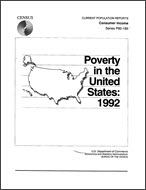Poverty in the United States: 1992
Poverty in the United States: 1992
Note To Users
The estimates in this report are controlled to national population estimates by age, race, sex, and Hispanic origin. The population controls used in the preparation of the estimates are based on results of the 1980 census carried forward to 1992. The estimates in this report, therefore, may differ from estimates that would have been obtained using 1990 census results brought forward to the survey date. Population controls incorporating 1990 census results will be used for survey estimation beginning in 1994.
Introduction
This report presents social and economic characteristics of the population below the poverty level in 1992 based on the March 1993 Current Population Survey (CPS). Transitions into and out of poverty are presented using data from the 1990 panel of the Survey of Income and Program Participation (SIPP). The poverty definition used in this report is that adopted for official government use by the Office of Management and Budget and consists of a set of money income thresholds that vary by family size and composition (see table A). Poverty status is based on responses to income questions which in the March CPS refer to income received in the previous calendar year. In this report, families or individuals with income below their appropriate poverty threshold are classified as below the poverty level. These poverty statistics exclude inmates of institutions, Armed Forces members in barracks, and unrelated individuals under 15 years of age.
Poverty thresholds are updated every year to reflect changes in the Consumer Price Index. For example, the average poverty threshold for a family of four was $13,924 in 1991 but $14,335 in 1992. Weighted average poverty thresholds in 1992 varied from $7,143 for a person living alone to $28,745 for a family of nine or more members. The poverty definition is based on pre-tax money income only, excluding capital gains, and does not include the value of noncash benefits such as employer-provided health insurance, food stamps, or Medicaid. For further discussion of this point, see the section entitled "Collection and Limitations of Poverty Data." The effect of taxes, realized capital gains, and the value of noncash benefits on poverty estimates are examined in P60-186RD, Measuring the Effect of Benefits and Taxes on Income and Poverty: 1992.
All demographic surveys, including CPS and SIPP, suffer from undercoverage of the population. This undercoverage results from missed housing units and missed persons within sample households. Compared to the level of the 1980 Decennial Census, overall CPS and SIPP undercoverage is about 7 percent. Undercoverage varies with age, sex, and race. For some groups, such as 20 to 24 year old Black males, the undercoverage is as high as about 35 percent. The weighting procedures used by the Census Bureau partially correct for the bias due to undercoverage. However, its final impact on estimates is unknown. For details, see appendix B.
The data in this report consist of cross-classifications of poverty status by such characteristics as age, race, Hispanic origin, family relationship, educational attainment, work experience, and type of income received. Although the primary focus of the report is on the United States as a whole, some tables also present data by region and type of residence. In addition, appendix D presents poverty estimates and rates for States for the years 1982 through 1992, based on CPS figures.
In the text, the terms "poverty population", "poor", and "below the poverty level" are used interchangeably, as are the terms "nonpoor" and "above the poverty level". Characteristics such as age and marital status are as of the survey date (March 1993), while income, poverty status, and work experience data refer to the whole previous calendar year (1992). In the report text, the year cited refers to the "income" year.
Others in Series
Publication
Publication
Publication






